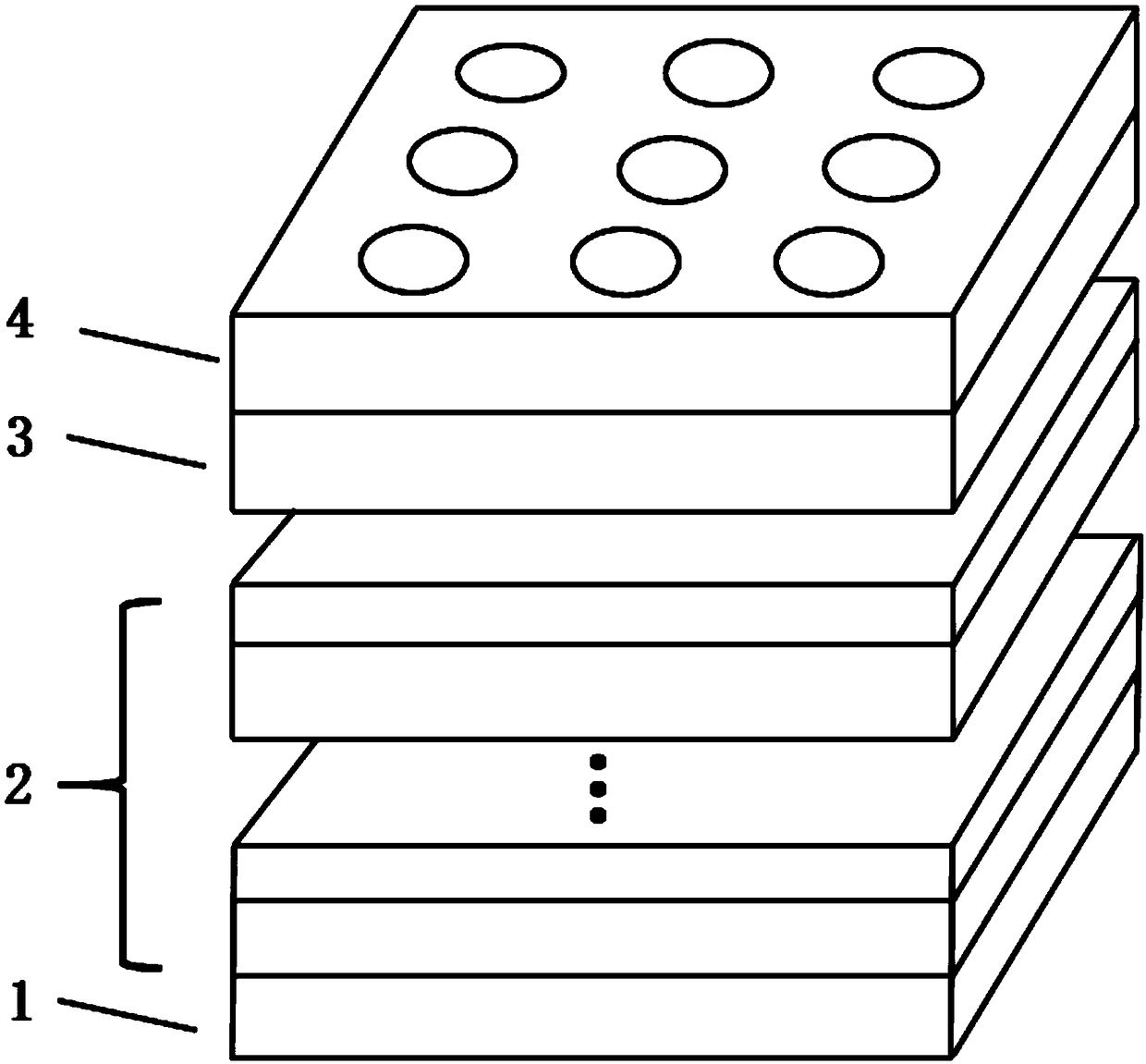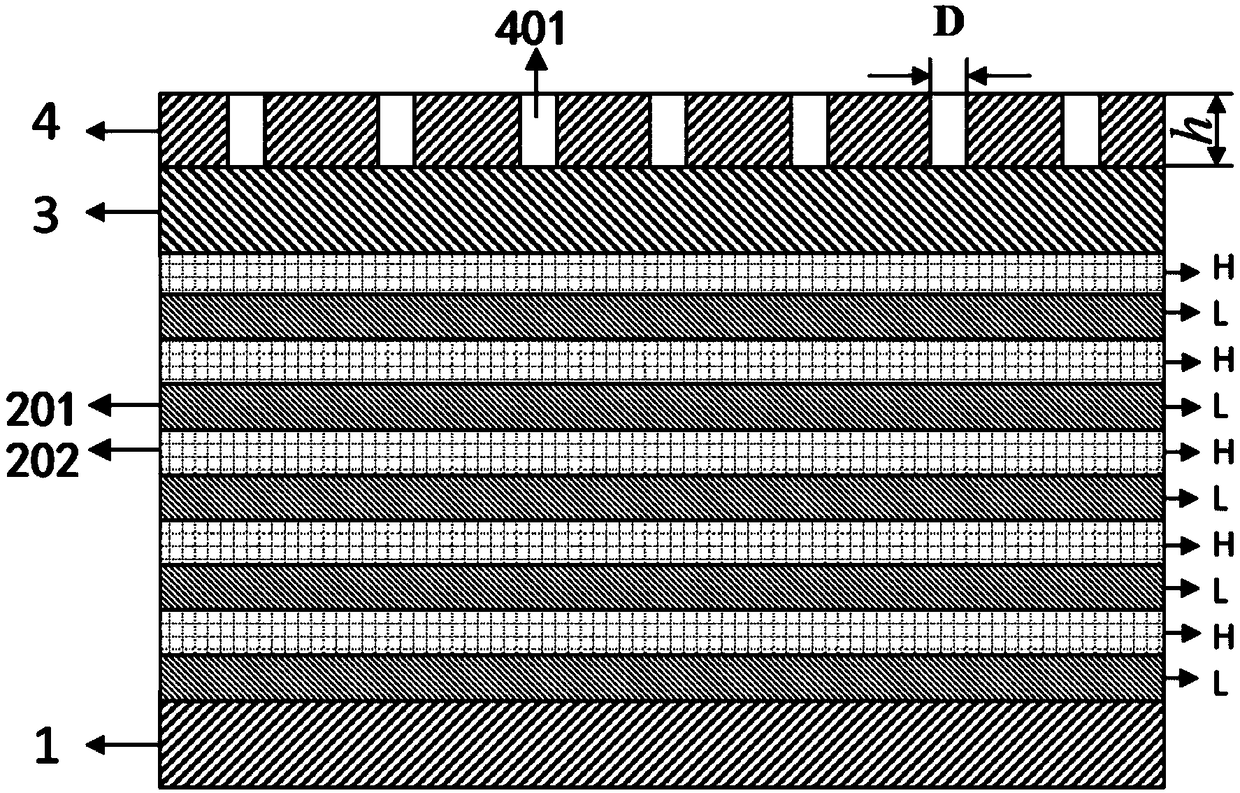Ernst bloch surface wave-based porous silicon biosensor and design method thereof
A biosensor, porous silicon technology, applied in the field of biosensors to achieve the effect of improving sensitivity
- Summary
- Abstract
- Description
- Claims
- Application Information
AI Technical Summary
Problems solved by technology
Method used
Image
Examples
Embodiment 1
[0053] like figure 1 As shown, a porous silicon biosensor based on Bloch surface waves includes a silicon substrate layer 1 , a Bragg mirror layer 2 , a buffer layer 3 and a hole-type photonic crystal grating layer 4 sequentially connected from bottom to top.
[0054] like figure 2 As shown, the Bragg reflector layer 2 includes N periodic high-porosity porous silicon layers 201 and low-porosity porous silicon layers 202 arranged alternately;
[0055] like image 3 As shown, the circular hole-type photonic crystal grating layer 4 is provided with a periodic array of air holes 401 arranged in a square lattice; the periodic array of air holes is arranged in a square with a lattice constant a.
[0056] The value of the air hole diameter D is changed from 200nm to 600nm, and the step size is set to 100nm; the value of the hole depth h is changed from 400nm to 800nm, and the step size is also set to 100nm.
[0057] The square lattice constant a is 1000±100 nm.
[0058] The tran...
Embodiment 2
[0065] figure 1 As shown, a porous silicon biosensor based on Bloch surface waves includes a silicon substrate layer 1 , a Bragg mirror layer 2 , a buffer layer 3 and a hole-type photonic crystal grating layer 4 sequentially connected from bottom to top.
[0066] like figure 2 As shown, the Bragg reflector layer includes N high-porosity porous silicon layers 201 and low-porosity porous silicon layers 202 alternately arranged periodically.
[0067] like image 3 As shown, the circular hole-type photonic crystal grating layer 4 is provided with a periodic array of air holes 401 arranged in a square lattice; the periodic array of air holes 401 is arranged in a square with a lattice constant a.
[0068] The value of the air hole diameter D is changed from 200nm to 600nm, and the step size is set to 100nm; the value of the hole depth h is changed from 400nm to 800nm, and the step size is also set to 100nm.
[0069] The square lattice constant a is 1000±100 nm.
[0070] Through...
Embodiment 3
[0074] like figure 1 As shown, a porous silicon biosensor based on Bloch surface waves includes a silicon substrate layer 1 , a Bragg mirror layer 2 , a buffer layer, and a hole-type photonic crystal grating layer 4 sequentially connected from bottom to top.
[0075] like figure 2 As shown, the Bragg reflector layer includes N periodic high-porosity porous silicon layers 201 and low-porosity porous silicon layers 202 arranged alternately;
[0076] like image 3 As shown, the circular hole-type photonic crystal grating layer 4 is provided with a periodic array of air holes 401 arranged in a square lattice; the periodic array of air holes is arranged in a square with a lattice constant a.
[0077] The value of the air hole diameter D is changed from 200nm to 600nm, and the step size is set to 100nm; the value of the hole depth h is changed from 400nm to 800nm, and the step size is also set to 100nm.
[0078] The square lattice constant a is 1000±100 nm.
[0079] Through the...
PUM
| Property | Measurement | Unit |
|---|---|---|
| thickness | aaaaa | aaaaa |
| thickness | aaaaa | aaaaa |
| diameter | aaaaa | aaaaa |
Abstract
Description
Claims
Application Information
 Login to View More
Login to View More - R&D
- Intellectual Property
- Life Sciences
- Materials
- Tech Scout
- Unparalleled Data Quality
- Higher Quality Content
- 60% Fewer Hallucinations
Browse by: Latest US Patents, China's latest patents, Technical Efficacy Thesaurus, Application Domain, Technology Topic, Popular Technical Reports.
© 2025 PatSnap. All rights reserved.Legal|Privacy policy|Modern Slavery Act Transparency Statement|Sitemap|About US| Contact US: help@patsnap.com



